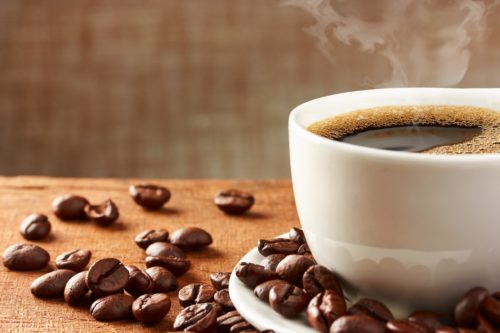

Here are 6 common foods and drinks that contain caffeine.

1. Coffee

Coffee is a brewed beverage prepared from coffee beans, which are a natural source of caffeine.

Revered for its taste and aroma around the world, coffee is consumed for its stimulating effects, which increases energy levels, mood, and alertness.
Whether coffee increases the risk of disease is controversial.

Some studies exploring the relationship between coffee consumption and the risk of disease have suggested an increased risk of heart disease, while others have shown potential health benefits, including a reduced risk of type 2 diabetes.
On average, an 8-ounce (240-mL) cup of coffee contains about 100 mg of caffeine.
At this level, 4 cups of coffee per day will keep you within the safe limit of 400 mg of caffeine for healthy adults.
Decaf coffee
In case you’re wondering, decaffeinated coffee still contains caffeine.
However, it has reduced levels compared with regular coffee.
One cup (240 mL) of decaf coffee contains 1–50 mg of caffeine, depending on the brand and serving size. That’s less than half the amount of caffeine in a regular cup.
A 2014 review study found that along with drinking regular coffee, drinking decaf coffee may reduce your risk of developing type 2 diabetes.
2. Cocoa beans and chocolate
Just like coffee beans, cocoa beans naturally contain caffeine.
This means that all chocolate and foods flavored with chocolate contain some caffeine, but the amount of caffeine in the product depends on the percentage of cocoa it contains.
Here’s about how much caffeine you’ll find in 3.5 ounces (100 grams) of different types of chocolate.
100% cocoa chocolate: 240 mg of caffeine — the equivalent of 2.5 cups of regular coffee
Bittersweet chocolate (55% cocoa): 124 mg of caffeine
Milk chocolate (33% cocoa): 45 mg of caffeine — around the amount of caffeine in a cup of black tea
Cocoa also contains compounds like flavonols and methylxanthines, and some studies have investigated its potential as a functional food.
These compounds, including caffeine, have antioxidant and anti-inflammatory properties and may provide health benefits.
That’s good news for chocolate lovers.
Summary
Cocoa beans contain caffeine, with the amount depending on the percentage of cocoa in the product.
A 3.5-ounce (100-gram) serving of pure cocoa can contain the same amount of caffeine as 2.5 cups of coffee, while milk chocolate contains less.
3. Kola nut
Native to West Africa, the kola nut is a staple food prized for its cultural symbolism and economic and health importance to all socioeconomic classes and religious groups.
It was once a main flavoring agent and source of caffeine in commercial colas like Coca-Cola.
However, some major cola brands no longer use it.
The kola nut is the seed of the kola tree and a natural source of caffeine.
You can eat it fresh or dried, and people use its extract as a food additive .
Although the kola nut itself has potential health benefits, regularly drinking sugar-containing sodas is associated with weight gain and other negative health consequences.
Summary
Kola nut extract is high in caffeine. Companies use it as a food additive and flavoring agent in some soft drinks, although some sources say commercial brands, including Coca-Cola, no longer use it.
4. Green tea
Another natural source of caffeine is green tea.
It’s an especially popular drink in Asian countries.
Green tea contains amino acids like theanine, which studies have shown act on the hippocampus in the brain and exert stress-reducing effects in animals and humans.
A 2017 study further suggested that the combination of theanine and caffeine in green tea may improve brain function and cognition, as well as reduce anxiety, although more research is needed (16).
An 8-ounce (240-mL) serving of green tea provides about 30–50 mg of caffeine, which is about half of the caffeine content of a cup of coffee.
The caffeine content of green tea varies by the age of the leaf. Older leaves provide less caffeine than younger leaves.
Summary
Green tea is a natural source of caffeine, providing about 30–50 mg of caffeine per 8-ounce (240-mL) serving, depending on the age of the leaves used.
5. Chewing gum
Chewing gum is a soft, rubbery substance traditionally made from tree sap.
It’s not a natural source of caffeine, but manufacturers may include caffeine in their recipes.
This has made chewing gum popular among some athletes and others looking for an energy boost.
Studies have shown that you absorb the caffeine in chewing gum much faster than caffeine in capsule form.
This is possibly because the buccal mucosa cells of the inner cheek absorb it quickly.
Caffeine enhances athletic performance. For this reason, caffeinated chewing gums, along with other sources of caffeine, are on the National Collegiate Athletic Association (NCAA) banned substances list for athletes.
Chewing gum that contains caffeine may increase your alertness and attention span.
Certain caffeinated versions, such as RunGum, provide 50 mg of caffeine in two pieces of gum.
Summary
Chewing gum is a soft, rubbery substance that has caffeine added to it during production. Some brands can provide up to 50 mg of caffeine.
6. Energy drinks
Energy drinks are carbonated, sweetened beverages marketed for their ability to boost energy levels, mood, and alertness.
However, energy drinks are sold as food supplements, not regulated by the FDA, and exempt from rigorous testing.
Therefore, it may be difficult to determine the caffeine content of some brands.
One study indicated that the caffeine content of energy drinks ranges from about 50–505 mg.
For example, the popular energy drink Red Bull contains 80 mg of caffeine per 8.4-ounce (250-mL) can.
In addition to caffeine, energy drinks contain taurine, an amino acid that is naturally found in the brain and possesses antioxidant properties.

Enock Akonnor is an experienced Ghanaian journalist, based in Kumasi and currently serves as the CEO and Managing Editor of www.leakyghana.com.
With a wealth of expertise built over many years in the media industry, he has earned a solid reputation as one of Ghana’s most sought-after journalists.
Contact:
📞 +233 541 921 562
✉️ enockakonnor2013@gmail.com










